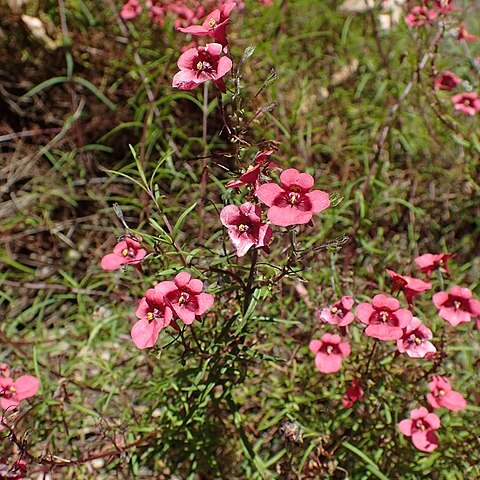Herbaceous, probably perennial (no basal parts seen), main stems woody, at least 300 mm long, up to 3 mm diam., sprawling, clambering up to 1 m, well-branched, glabrous. Leaves patent, mostly 15-36 x 2-4.5 mm, ratio at least 10:1, diminishing in size upwards, linear-lanceolate or lanceolate, apex acute, base cuneate, margins entire or with a few sharp teeth, glabrous, petioles 1-1.5 mm long. Flowers few, in lax terminal racemes; bracts up to c. 4 x 2 mm, ovate, very acute, or sometimes the lowermost pair leaf-like, glandular-puberulous; pedicels 13-20 mm long, ascending at an angle of c. 45°, they and the inflorescence axis glandular-puberulous. Calyx segments probably spreading, lanceolate, two anticous ones c. 3-4 x 1.5 mm, three posticous ones slightly smaller, all glandular-puberulous. Corolla tube c. 4-5 mm long, scarcely invaginated, two lateral spurs c. 4-5 mm long, straight, diverging at an angle of c. 45°, with a patch of dark sessile glands within near the tip; limb c. 12-17 x 10-17 mm, anticous lobe 5-9 x 11, lateral lobes 3.5-5 x 3.5-6 mm, posticous lobes 3-4 x 3.5-4.5 mm, all subrotund, “claret-red” (Fourcade) “red” (Acocks) or “orange-red” (Taylor), sparsely glandular-puberulous outside, glabrous inside except for a transverse band of dark sessile glands at the base of the lower lip, sometimes a few glands below the upper sinuses as well, the “window” shallowly concave. Stamens possibly erect; filaments 2.5 mm long, minutely glandular-puberulous, hairs very few; anthers 0.5 mm long, cohering. Ovary 1.5 x 1.25 mm, deltoid in outline, ovules many in each loculus, style 1.5 mm long, stigma capitate. Capsules c. 6 x 3; seeds c. 1.5 mm long, curved, broadly winged, ribbed.
More
Perennial herb or suffrutex, up to 1 m high; stems well branched, sprawling or scrambling through other plants, sometimes rooting. Leaves patent, narrow-linear to lanceolate, acute, glabrous; petioles 1.0-1.5 mm long. Flowers few; pedicels 13-20 mm long, ascending. Corolla lobes shades of pink or red, 1 orange with transverse band of dark, sessile glands on lower lobe at base; window somewhat hollow. Spurs ± 4-5 mm long, straight but diverging at ± 45°. Flowering time May-Aug., Dec.
Perennial to 1 m. Leaves linear to ovate, entire or with a few, sharp teeth. Flowers in racemes, 2-spurred, pink to red with a yellow window, 12-17 mm long, spurs projecting backwards and down or diverging at nearly right angles, ± 4-7 mm long. Capsules ovate, 4.5-15.0 x 4-6 mm.

